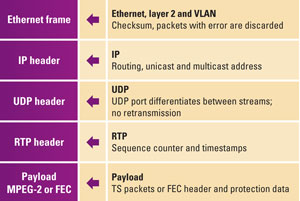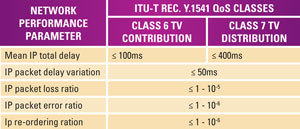The appeal of IP
The shift to IP within broadcasting is well under way. The multiple benefits afforded by IP networking, coupled with technology advancements and new capabilities to control quality and manage IP processes nearly to the degree you can in point-to-point networks, make this drive to IP all the more inevitable. This shift is coinciding with an astounding proliferation of connected devices that is causing a disruptive change in video and content consumption.
As we move to a converged media environment, how people consume their media will drive the market. Adopting proven IT practices and deploying IP technologies may well be the most significant path to long-term success and future revenue opportunities.
Consider IP’s appeal from a core technology perspective. From a single interface, broadcasters and service and content providers can securely transport video signals to one or more receivers in a network without having to dig trenches, move cables, or add encoders or decoders at the network edge. They can also set up or add connections or take them down on demand — quickly and easily. This is powerful stuff and critical in today’s broadcasting environment, which is increasingly driven by live streaming media — whether live events from a “traditional” broadcaster or streaming programming to a connected device. Broadcasters could view IP as one big virtual video router that spans the globe and runs on IP instead of traditional equipment.
Yet IP isn’t just suited for the big scale. A considerable share of IP solutions in the professional video realm consist of simple networks such as studio-to-transmitter links. IP’s technology allows easy and reliable connections, and when combined with Ethernet, is a universal solution for small systems to large, complex networks. IP networks are scalable, cost-effective, inherently flexible and available at a range of bandwidths, including 10Mb/s, 100Mb/s, 1Gb/s and 10Gb/s. Yet, in the broadcast world, however, IT/IP processes/signal transport must be highly protected and securely managed.
SIDEBAR:
Video and IP: A merger completed
Adopting proven IT practices and deploying IP technologies offers several advantages. IP technologies:
- Enable broadcasters and content providers to more easily and economically deliver content to where it is needed, when it is needed.
- Scale easily to individual needs and budgets.
- Protect investment by providing a flexible video networking system that embraces evolving architectures and services.
- Reduce operational costs and complexity through built-in intelligence.
- Ensure high-quality standards with integrated end-to-end management capabilities.
- Offer substantial OPEX savings through multiple services on a common infrastructure, with benefits multiplying as more services are migrated to IP.
Benefits by design
The advantages of IP extend beyond operational expense (OPEX) and capital expense (CAPEX) savings. Once broadcast services are managed within the IP domain, broadcasters can transform production, post-production, contribution, and distribution of core video and audio assets. The ability to share these assets quickly and efficiently on a shared IP network infrastructure can unleash unprecedented collaboration, efficiency and agility throughout the entire broadcast value chain and enable the rapid introduction of new services, including HD video and content delivery over multiple platforms.
The professional video industry's #1 source for news, trends and product and tech information. Sign up below.
Distribution of national and local DVB-T services to transmitter sites can also benefit from the CAPEX and OPEX saving of an IP-based network. And, once DVB-T services are managed within the IP domain, they can easily be delivered over fiber, copper or microwave networks, and within systems encompassing all three.
Finally, broadcasters can deliver TV services to consumers over multiple platforms and multiple connected screens — TV, PC and mobile devices — both in the home and on the go. Solutions must accommodate diverse video formats, quality levels and compression standards, as well as deliver the highest quality for the lowest cost. IP provides a common framework for easily adapting and distributing TV services for any platform or device.
“Connection-less” routing
The process of packetized content delivery, distinguished from traditional technologies such as ATM and SDH, may hold the key to IP efficiency. With traditional “connection-oriented” technologies, a path must be set up across the network from origin to destination before any traffic can be sent.
IP offers a fundamentally different paradigm, in which the network itself determines the optimal path for transmitting traffic to its destination at any given moment, and routes traffic dynamically. In the packet-based IP model, the transmission path to the destination is not set up in advance.
Instead, an end station wraps data inside a packet “container,” stamps it with an origin and destination address, and sends it into the network. The network then uses the IP addresses to transport the packet to its destination through “connection-less” packet forwarding or IP routing. The nodes, or routers, forwarding these IP packets constantly update each other about the reachability of IP addresses and/or networks through the use of IP routing protocols. Today’s IP routing protocols allow every router in the network to individually build a full topology view of the IP network.

Table 1. The SMPTE 2022-2 standard describes how to map transport streams onto an IP network using UDP and RTP.
This connection-less nature of IP networks provides critical advantages. Because paths are not established in advance, provisioning is easier and more cost-efficient.
IP networks are also inherently resilient; the network will always reroute around any link or router failure —assuming the network has been properly designed with resilient nodes and links. This allows IP networks to survive multiple link and node failures, which is not always achieved with path-protected networking technologies. (See Table 1.)
SIDEBAR:
Connection-less IP
The connection-less nature of IP networks provides many advantages:
- The host software is much simpler at the network layer.
- The transport layer already provides connections, so no repeating is necessary.
- There is no limit to network access or traffic overload.
- An open, standards-based and widely adopted transport solution ensures future longevity and competitive pricing.
- Connection-less IP provides exceptional flexibility, with near-infinite bit-rate granularity and easily adaptable routing capabilities
More functionality, better protection
New solutions including universal IP video access modules contain all the functionality in compact form factors (as small as 1RU) that until recently required a full rack. This multi-functionality now encompasses comprehensive service monitoring, protection switching, media conversion and security, as well as management and control. This type of technology serves to increase the availability of media networks over IP, delivering quality, flexibility and end-to-end video stream protection, while solving the uncertainty of IP networks’ lack of guaranteed quality, uptime, latency and packet loss.

Table 2. IP network QoS class definitions and network performance objectives
Protection schemes including Forward Error Correction according to SMPTE 2022-1 for transport streaming, as well as diverse path routing and protection switching, and encoder protection provide the highest possible QoS and minimize the effects of random packet losses, burst packet losses, losses due to fast re-routes and link failures that can be associated with IP video transport. (See Table 2.)
Of course, end-to-end network management is required to prevent overflow by securing sufficient capacity for the media and to support controlled re-routing.
Convergence drives new opportunities
Economies of scale, built-in flexibility, lower network operating and capital costs, increased flexibility, and the ability to push more content/increased bandwidth are among IP’s most compelling benefits. But perhaps even more significant is creating a reliable media network that can best serve broadcasters and content providers now and into the future.
IP is driving delivery of creative content through broadband or wireless networks for display on connected devices of all kinds, from mobile phones, laptops and notebooks to connected televisions. Business models are evolving before our eyes to profit from the growing consumer expectation for “on-demand” content.
IP networks can take advantage of new ways to monetize and leverage content — from more channels and local content insertion to the ability to push content to second screens. Greater ability to reach end users on all of their connected devices will be critical to success in the decades to come.
—Janne T. Morstøl is chief product and marketing officer for Nevion.
